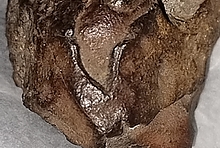Home PageAbout MindatThe Mindat ManualHistory of MindatCopyright StatusWho We AreContact UsAdvertise on Mindat
Donate to MindatCorporate SponsorshipSponsor a PageSponsored PagesMindat AdvertisersAdvertise on Mindat
Learning CenterWhat is a mineral?The most common minerals on earthInformation for EducatorsMindat ArticlesThe ElementsThe Rock H. Currier Digital LibraryGeologic Time
Minerals by PropertiesMinerals by ChemistryAdvanced Locality SearchRandom MineralRandom LocalitySearch by minIDLocalities Near MeSearch ArticlesSearch GlossaryMore Search Options
The Mindat ManualAdd a New PhotoRate PhotosLocality Edit ReportCoordinate Completion ReportAdd Glossary Item
Mining CompaniesStatisticsUsersMineral MuseumsClubs & OrganizationsMineral Shows & EventsThe Mindat DirectoryDevice SettingsThe Mineral Quiz
Photo SearchPhoto GalleriesSearch by ColorNew Photos TodayNew Photos YesterdayMembers' Photo GalleriesPast Photo of the Day GalleryPhotography
╳Discussions
💬 Home🔎 Search📅 LatestGroups
EducationOpen discussion area.Fakes & FraudsOpen discussion area.Field CollectingOpen discussion area.FossilsOpen discussion area.Gems and GemologyOpen discussion area.GeneralOpen discussion area.How to ContributeOpen discussion area.Identity HelpOpen discussion area.Improving Mindat.orgOpen discussion area.LocalitiesOpen discussion area.Lost and Stolen SpecimensOpen discussion area.MarketplaceOpen discussion area.MeteoritesOpen discussion area.Mindat ProductsOpen discussion area.Mineral ExchangesOpen discussion area.Mineral PhotographyOpen discussion area.Mineral ShowsOpen discussion area.Mineralogical ClassificationOpen discussion area.Mineralogy CourseOpen discussion area.MineralsOpen discussion area.Minerals and MuseumsOpen discussion area.PhotosOpen discussion area.Techniques for CollectorsOpen discussion area.The Rock H. Currier Digital LibraryOpen discussion area.UV MineralsOpen discussion area.Recent Images in Discussions
Identity HelpQueensland secondary mineral roundup
18th Mar 2009 04:20 UTCRyan Eagle Expert
1. George Fisher mine, Mount Isa, Queensland, Australia. Yellowish mineral growing on quartz, could be anglesite?
2. Another from Mount Isa, growing on galena. Pyromorphite-Mimetite or one of the silver minerals such as pyrargyrite that occur there?
3. Barbara copper mine, Mount Isa. Much the same type of mineralisation as any of the other copper mines in the area, not much info on this specific mine though. The reddish-brown alteration surrounding chalcopyrite. Initially, without a microscope, I suspected massive chalcocite but I'm not very confident of that getting up close.
18th Mar 2009 05:27 UTCRob Woodside 🌟 Manager
18th Mar 2009 05:47 UTCRalph S Bottrill 🌟 Manager
Ralph
18th Mar 2009 06:09 UTCRob Woodside 🌟 Manager
18th Mar 2009 06:16 UTCRyan Eagle Expert
18th Mar 2009 07:40 UTCRyan Eagle Expert
18th Mar 2009 07:58 UTCRob Woodside 🌟 Manager
PS I didn't want to increase thread length, but Ralf that was agreat job you did on Crocoite on the best stuff board!!!
18th Mar 2009 08:45 UTCUwe Kolitsch Manager
2: I'd vote for pyromorphite-mimetite (rosette-like aggregates of tabular xls).
18th Mar 2009 08:54 UTCRob Woodside 🌟 Manager
18th Mar 2009 09:02 UTCRyan Eagle Expert
As for jarosite, I knew we had found it somewhere in the pit before, so I dug through my piles of rocks and found a bit. The crystals are even smaller than the things in the number 2 photo, so it's a pretty atrocious photo, it literally has a 1mm field of view. I am quite confident of these ones being jarosite, they were well in the oxidised zone, before we hit sulphides. Matches up well with the images in the database.
One thing that suprised me at Handlebar Hill was the almost complete absence of secondary zinc minerals... they really were scarce, but the one piece of smithsonite I picked up was pretty spectacular on the small scale.
edit: closer photo of the 'anglesite', these things are impossible to make look good. ordering my micro focus rack right NOW.
18th Mar 2009 09:42 UTCSebastian Möller Expert
1. Anglesite or cerussite then (try to dissolve in hydrochloric acid, cerussite will do with giving lead chloride)
3. Limonite with possibly cuprite
2. all minerals mentioned seem reasonable to me without cuprite. It is clearly brownish, whereas most cuprites show a red colour. First I thought sphalerite, but this could really be some alunite group mineral such as jarosite.
Regards,
Sebastian Möller
18th Mar 2009 11:28 UTCRalph S Bottrill 🌟 Manager
Thanks Rob for the compliments, I hope to get a few more up soon.
Ralph
18th Mar 2009 12:20 UTCRyan Eagle Expert
18th Mar 2009 20:04 UTCRob Woodside 🌟 Manager




Mindat.org is an outreach project of the Hudson Institute of Mineralogy, a 501(c)(3) not-for-profit organization.
Copyright © mindat.org and the Hudson Institute of Mineralogy 1993-2024, except where stated. Most political location boundaries are © OpenStreetMap contributors. Mindat.org relies on the contributions of thousands of members and supporters. Founded in 2000 by Jolyon Ralph.
Privacy Policy - Terms & Conditions - Contact Us / DMCA issues - Report a bug/vulnerability Current server date and time: April 29, 2024 15:08:50
Copyright © mindat.org and the Hudson Institute of Mineralogy 1993-2024, except where stated. Most political location boundaries are © OpenStreetMap contributors. Mindat.org relies on the contributions of thousands of members and supporters. Founded in 2000 by Jolyon Ralph.
Privacy Policy - Terms & Conditions - Contact Us / DMCA issues - Report a bug/vulnerability Current server date and time: April 29, 2024 15:08:50











